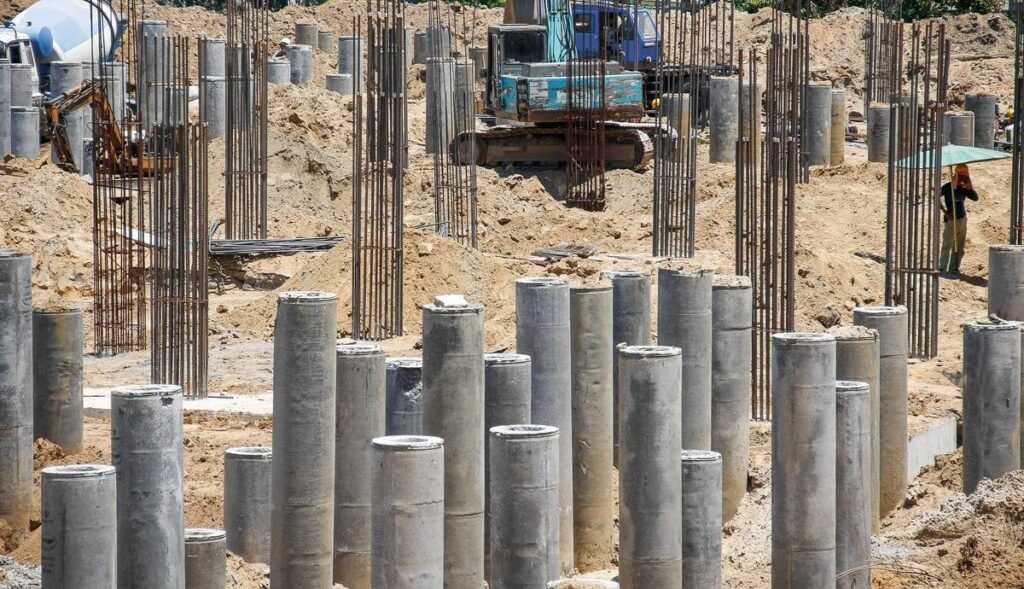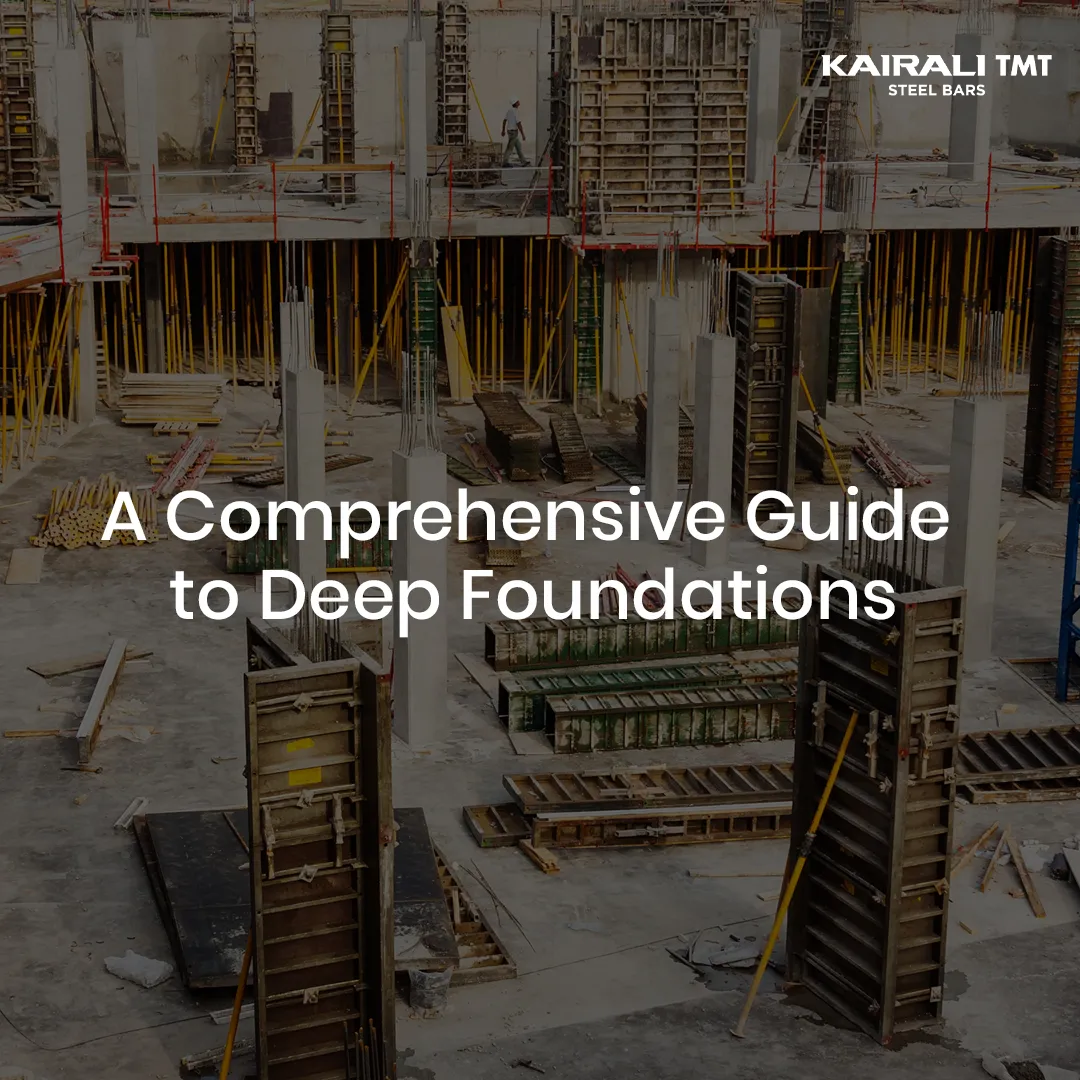In construction, you can see different types of foundations. And, each caters to different load-bearing needs.
A building’s foundation is without a doubt a huge deal. It’s what supports the entire building above the ground. But did you know that the foundation of a house can vary from that of a massive structure? Well, yeah.
Here, we are going to look into each type of foundation. Keep reading to learn about them.
What is a Foundation in Construction?
The foundation is the part of a structure that passes the load from the building to the ground.
It’s a must to transfer this load without causing any excessive stress on the ground. This helps to prevent the structure from sinking or collapsing.
The foundation is also the link between the building and the earth, ensuring that the weight distribution is even.
Types of Foundations in Construction
Type #1: Shallow Foundations

Shallow foundations are ideal when the soil near the surface has enough strength and stiffness to support the loads of the structure.
In this type of foundation, the depth is generally less than the width.
Shallow foundations are widely used in residential, light commercial, and some low-rise industrial structures.
Spread footings or open footings are some of the other names of Shallow Foundations.
Advantages
- They’re cost-effective and simple.
- They don’t require much excavation and need only fewer materials, helping reduce construction costs.
Disadvantages
- They don’t go hand in hand with all soil types
- They can incur damage to changes in soil conditions, such as variations in moisture.
- They aren’t ideal for heavy structures or those with significant load-bearing requirements.
Type #2: Deep Foundations
A deep foundation is one of the types of foundations that are ideal for weak or compressible upper soil layers.
Here, it transfers the building’s load to the deep part of the ground where there is stable soil.
You can go for this foundation for tall buildings, bridges, and marine structures.
Deep foundations can be further divided into two categories – pile foundations and drilled shafts.
Advantages
- They provide greater stability for structures built on poor soils or areas with high water tables.
- They can resist uplift forces from wind or seismic activity better than shallow foundations.
Disadvantages
- They are complex.
- They are expensive.
- Their installation requires special equipment and techniques.
- Mistakes in installation can be costly to repair.
Type #3: Pile Foundations

A Pile foundation is a deep foundation.
Wondering where they are used? Their typical applications include large structures and buildings constructed over water bodies.
They consist of long, slender, columnar elements driven deep into the ground to transfer loads through weak soils to stronger ones below.
Steel, concrete, or timber can be used to create piles.
Advantages
- Their load-bearing capacity is impressive.
- They are good at resisting uplift forces effectively.
- They are suitable for areas with challenging soil conditions or high water tables.
Disadvantages
- Pile foundation construction is time-consuming and requires substantial investment.
- It also demands skilled labour and precise engineering calculations.
Type #4: Raft or Mat Foundations

Raft foundations, also known as mat foundations, are a type of shallow foundation that spreads the load from the building over a large area.
These types of foundations are like a raft floating on the soil, hence the name.
They are typically used when the soil has low bearing capacity, or when the structure’s load is distributed over a large area, such as in high-rise buildings.
Advantages
- They provide excellent stability and evenly distribute the load across the entire footprint of the building, reducing the risk of differential settlement.
- They also require less excavation depth than deep foundations.
Disadvantages
- They can be expensive due to the large amount of concrete required.
- They’re not suitable in areas with high groundwater levels or aggressive soil conditions.
Type #5: Strip Foundations: One of the Common Types of Foundations

Strip foundations are also known as wall footings.
This is a variation of a shallow foundation, which supports a line of loads, such as a load-bearing wall.
This foundation is usually a strip of concrete spread along the length of the wall, making it suitable for light-loaded structures like residential buildings.
Advantages
- They are simple to construct and require less concrete than other types, making them cost-effective.
- They are suitable for stable ground conditions and buildings with relatively light loads.
Disadvantages
- They aren’t suitable for heavy structures or areas with poor soil conditions.
- Any differential settlement could lead to cracks in the walls supported by the strip foundation.
Type #6: Pad Foundations

Pad foundations, also known as isolated or individual footings, are a type of shallow foundation used to support individual points of load, such as columns.
They are typically square or rectangular slabs of concrete.
Planning to construct residential or low-rise commercial buildings, this foundation would be perfect.
Advantages
- This is a cost-effective option.
- You can easily design and build this foundation.
- They are suitable for light to medium-loaded structures built on strong and stable soils.
Disadvantages
- They are not suitable for heavy structures or those built on weak soils.
- They are susceptible to differential settlement issues.
Type #7: Grillage Foundations
Grillage foundations are a special kind of shallow foundation composed of one or more layers of beams, called grillage beams, laid perpendicular to each other.
They are suitable for heavy structures built on soft soils as they distribute the load over a large area.
Grillage foundations are often used for bridges, piers, and heavy column loads.
Advantages
- They are advantageous due to their high load-bearing capacity and ability to distribute loads evenly.
- They can be constructed quickly and require less excavation than deep foundations.
Disadvantages
- They can be expensive due to the high cost of steel beams.
- They may not work at their best in areas with high water tables or corrosive soil conditions.
Type #8: Combined Footing Foundations

Combined footing foundations are a type of shallow foundation that supports two or more columns, typically when they are close to each other or near a property boundary.
These footings can be rectangular or trapezoidal in shape.
This works best for row houses, bridges, and multi-storey buildings.
Advantages
- Firstly, they provide excellent support for multiple columns and help prevent differential settlement.
- What’s more, they can also save space and decrease excavation costs.
Disadvantages
- Its design part can be difficult and require careful calculations and expertise.
- They can be expensive because they require more concrete and reinforcement.
Type #9: Floating Foundations
Floating foundations, as the name suggests, are designed to ‘float’ on the soil, like a boat on water.
They are used when the soil has a low bearing capacity, and the building’s weight is less than the weight of the soil it displaces.
Floating foundations are typically used for lightweight structures or in areas with expansive clay soils.
Advantages
- They can significantly reduce settlement and are effective in areas with problematic soil conditions.
- They distribute the load evenly, reducing stress on the soil.
Disadvantages
- They are complex to design and construct, requiring skilled engineering.
- They may not be suitable for heavy structures or areas with high groundwater levels.
Winding Up
From shallow to deep foundations, from pile to raft, and strip to pad, there are different types of foundations that cater to different needs. We hope that now it’s clear to you about each type and where to use them.


